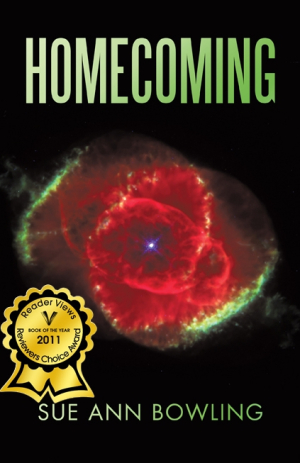Homecoming
Well-written science fiction expands the imagination. It is a book genre that explores the outer limits of reality, based on the reasoning and endless possibilities of science. Unfortunately, there is too much science fiction on the market today that has left this creative path of exploration, and instead offers readers a constantly rehashed mix of starship battle scenes and evil alien races bent on taking over the universe. Fortunately, in Homecoming, Sue Ann Bowling takes the reader back to the foundations of sci-fi, offering a completely original story, with both fresh ideas and sound science.
Homecoming focuses on three central characters, Lai, Marna, and Snowy. Lai is the only member of his species, the R’il’nains, left in the confederation. His people were once vast and powerful, but they were destroyed by disease. Marna is the last survivor of her planet. She has lived for over two centuries in isolation, maintaining a beacon to warn other life forms away from her home world, where a plague destroyed the entire population. Snowy is a slave. He dances with his best friends, and tries to hide the powers he is not supposed to have as a human.
The stories of these three individuals begin to intersect when Snowy is purchased by Derik, a R’il’naian-human crossbreed called a R’il’noid, who is also Lai’s half brother. When Snowy suddenly falls ill with a disease known as Kharfun, however, Derik realizes that Snowy cannot be entirely human, and only humans can be slaves. While Lai, Marna, and Snowy all have vastly different agendas, they must come together not only to find happiness in their own lives, but to help create a better world for the entire confederation.
Homecoming is a truly compelling book. The author has done a superb job of creating characters that are well rounded and emotionally real. The plot is original and thoughtfully crafted, and the supporting science is fresh and exciting. For instance, when several of the characters find themselves on an unknown planet and must forage for food, the author writes, “Biological processes on any particular planet tended to use and produce a single suite of amino acids, apparently depending on which coiling direction of DNA won out in the earliest stages of evolution on that world. Marna could no more survive on food from a planet where life used amino acids that were mirror images of those in her own body than her right hand would fit smoothly in a left-hand glove.”
The author leaves a great deal unresolved at the end of the book. Though somewhat frustrating, in all likelihood, it is unavoidable with such a complicated plot. In any case, the reader will turn the last page hoping that a sequel is on the way.
Reviewed by
Catherine Thureson
Disclosure: This article is not an endorsement, but a review. The publisher of this book provided free copies of the book and paid a small fee to have their book reviewed by a professional reviewer. Foreword Reviews and Clarion Reviews make no guarantee that the publisher will receive a positive review. Foreword Magazine, Inc. is disclosing this in accordance with the Federal Trade Commission’s 16 CFR, Part 255.

